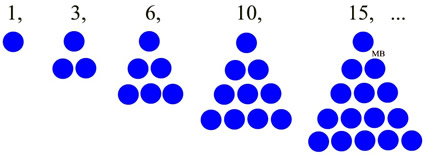Examples of Patterns with Objects: |
When working with objects, look for changes in the object itself, changes between the objects, and/or transformations of the object.
Consider the following lists of objects and their patterns:
| Sequence |
Pattern |
|
The triangles are growing by one "row" of blue circles each time. The number of circles comprising the triangles is 1, 3, 6, 10, 15, where the number of circles in the new row is added each time: 2, 3, 4, 5,... added.
The next triangle will have 21 circles (15 + 6 from a new row).
|
|
The figures appear to be regular polygons. Each figure has one more side than the previous figure. The next figure is a septagon (7 sides). |
|
This pattern has no numeric connection. The pattern is a transformation. The black circle is moving clockwise around the grid. the next term will be the same as the first. |
|
Two patterns exist between every other die. The first, third, fifth, (etc.) die is each 6. while the second, fourth, sixth, (etc.) die is a counting number starting with 1.
6, 1, 6, 2, 6, 3, ... next die will be 6.
|
|
The figure is rotating counter- clockwise by 90º each time. Under these transformations, the next figure will be the same as the first figure. |
Examples of Patterns with Letters: |
Some lists may contain only letters. Consider how the pattern is developing, and/or what you know about the locations of the letters in the alphabet.
|
| Sequence |
Pattern |
a, c, e, g, i, k, m, ... |
The pattern is every other letter of the alphabet starting with a. The next letter is o. |
a, z, b, y, c, x, d, ... |
The letters are alternating with letters starting with a and moving forward, and letters starting at z and moving backward. a, z, b, y, c, x, d,... The next letter is w. |
b, e, h, k, n, q, ... |
Starting with the letter b, this pattern is every third following letter. The next letter will be t. |
m, n, o, m, n, o, m, ... |
There is a repetition in this pattern of the letters m, n, o.
The next letter will be n. |
b, g, d, i, f, k, ... |
Determining this pattern requires looking at the locataion positions of the letters in the alphabet.
b, g, d, i, f, k = 2, 7, 4, 9, 6, 11.
The red values are even numbers (every other term).
The black values are 5 more than their preceding even values. The next term is h which is 8. |
|





